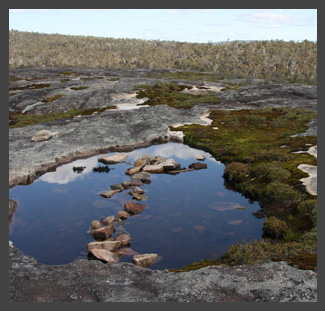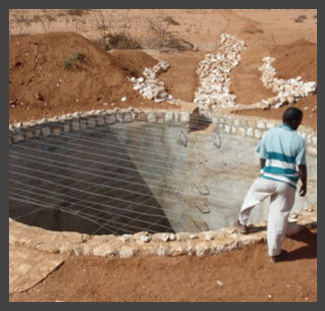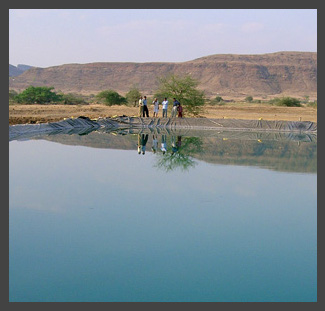Difference between revisions of "Ground Catchment"
(→Acknowledgements) |
|||
| (18 intermediate revisions by 3 users not shown) | |||
| Line 1: | Line 1: | ||
| + | {{Language-box|english_link=Ground Catchment | french_link=Le captage de surface |spanish_link=Coming soon|hindi_link=Coming soon|malayalam_link=Coming soon|tamil_link=Coming soon | korean_link=Coming soon | chinese_link=地表集水区 | indonesian_link=Coming soon | japanese_link=Coming soon }} | ||
| + | |||
Open reservoirs can be used to capture rainwater runoff for agriculture or domestic use and for recharging an aquifer. Oftentimes these natural reservoirs are the cheapest option for water storage. However, modifications can be made to increase volumes or gain access to the water. Small dams can be built or linings (to prevent infiltration) can be added. Diversions can also be created to send water to crops or nearby villages. For additional expense, [[underground tank]]s can be built in a runoff basin, which can be made with an increased depth to width ratio (more deep than wide), which means less evaporation losses overall. | Open reservoirs can be used to capture rainwater runoff for agriculture or domestic use and for recharging an aquifer. Oftentimes these natural reservoirs are the cheapest option for water storage. However, modifications can be made to increase volumes or gain access to the water. Small dams can be built or linings (to prevent infiltration) can be added. Diversions can also be created to send water to crops or nearby villages. For additional expense, [[underground tank]]s can be built in a runoff basin, which can be made with an increased depth to width ratio (more deep than wide), which means less evaporation losses overall. | ||
| − | + | <small-title /> | |
'''Climate change considerations'''<br> | '''Climate change considerations'''<br> | ||
Less rainfall and longer dry periods mean reduced soil moisture for crops. Groundwater recharge may be reduced if infiltration decreases. Many near-coast aquifers will be at risk from salt water intrusion as a result of sea level rise. Ponds, tanks, and reservoirs may not fill enough to support agriculture, or may be damaged by extreme floods. Larger more intense floods could also cause catastrophic, large dam failures. Open water reservoirs could create breeding grounds for mosquitoes, which can lead to increased malaria and water-borne diseases. Therefore, smaller reservoirs help reduce risk and expense. | Less rainfall and longer dry periods mean reduced soil moisture for crops. Groundwater recharge may be reduced if infiltration decreases. Many near-coast aquifers will be at risk from salt water intrusion as a result of sea level rise. Ponds, tanks, and reservoirs may not fill enough to support agriculture, or may be damaged by extreme floods. Larger more intense floods could also cause catastrophic, large dam failures. Open water reservoirs could create breeding grounds for mosquitoes, which can lead to increased malaria and water-borne diseases. Therefore, smaller reservoirs help reduce risk and expense. | ||
| − | <div style=" background-color: #efefef; text-align: center; -moz-border-radius: | + | <div style=" background-color: #efefef; text-align: center; -moz-border-radius: 2px; -webkit-border-radius: 2px; border: 5px solid #dedede; padding: 5px;" > |
| − | {|cellpadding=" | + | {|cellpadding="5" cellspacing="0" width="100%" |
|- | |- | ||
| − | | | + | |colspan="5" style="background-color:#efefef;"| |
| − | |||
| − | |||
|- | |- | ||
| − | |style="background:#efefef;"|[[Image:bare rock catchment small.jpg|center| | + | |style="background:#efefef;"|[[Image:bare rock catchment small.jpg|center|100px|link=Natural rock catchment and Open water reservoir]] |
| − | |style="background:#efefef;"|[[Image:subsurface tank small.jpg|center| | + | |style="background:#efefef;"|[[Image:subsurface tank small.jpg|center|100px|link=Natural or artificial ground catchment and Lined sub-surface tanks]] |
| − | |style="background:#efefef;"|[[Image:natural lined pond small.jpg|center| | + | |style="background:#efefef;"|[[Image:natural lined pond small.jpg|center|100px|link=Natural ground catchment and Open water reservoir]] |
|- | |- | ||
|style="background:#efefef;"|<div class="center" style="width:auto; margin-left:auto; margin-right:auto;">[[Natural_rock_catchment_and_Open_water_reservoir|Natural rock <br>catchment and <br>Open water reservoir]]</div> | |style="background:#efefef;"|<div class="center" style="width:auto; margin-left:auto; margin-right:auto;">[[Natural_rock_catchment_and_Open_water_reservoir|Natural rock <br>catchment and <br>Open water reservoir]]</div> | ||
|style="background:#efefef;"|<div class="center" style="width:auto; margin-left:auto; margin-right:auto;">[[Natural_or_artificial_ground_catchment_and_Lined_sub-surface_tanks|Natural or artificial<br> ground catchment and <br>Lined sub-surface tanks]]</div> | |style="background:#efefef;"|<div class="center" style="width:auto; margin-left:auto; margin-right:auto;">[[Natural_or_artificial_ground_catchment_and_Lined_sub-surface_tanks|Natural or artificial<br> ground catchment and <br>Lined sub-surface tanks]]</div> | ||
|style="background:#efefef;"|<div class="center" style="width:auto; margin-left:auto; margin-right:auto;">[[Natural_ground_catchment_and_Open_water_reservoir|Natural ground <br>catchment and <br>Open water reservoir]]</div> | |style="background:#efefef;"|<div class="center" style="width:auto; margin-left:auto; margin-right:auto;">[[Natural_ground_catchment_and_Open_water_reservoir|Natural ground <br>catchment and <br>Open water reservoir]]</div> | ||
| + | |- | ||
| + | |colspan="5" style="background-color:#efefef;"| | ||
|} | |} | ||
</div> | </div> | ||
<br> | <br> | ||
| − | <font size=" | + | ===Ground catchment and storage links=== |
| + | * [http://www.nwp.nl/_docs/Smart-solutions-3R.spread.pdf 3R Smart Solutions] | ||
| + | * <font size="3">[http://www.bgs.ac.uk/africagroundwateratlas/index.cfm Africa Groundwater Literature Archive]</font>: The Archive is a searchable database of published and unpublished groundwater literature about Africa, including reports, journal articles, conference papers and maps. Many of these documents are freely available to download; for others, a link is provided to the online abstract, or a full bibliographic reference is given where the document is not known to be available online. | ||
* [http://smallreservoirs.org/ Small Reservoirs Project.] Small Reservoirs Project: Planning and evaluating ensembles of small, multipurpose reservoirs for the improvement of smallholder livelihoods and food security. | * [http://smallreservoirs.org/ Small Reservoirs Project.] Small Reservoirs Project: Planning and evaluating ensembles of small, multipurpose reservoirs for the improvement of smallholder livelihoods and food security. | ||
| − | * [ | + | * [https://sswm.info/sites/default/files/reference_attachments/UN-HABITAT%202005%20Rainwater%20Harvesting%20and%20Utilisation%20Book%202.pdf Rainwater Harvesting and Utilisation, Blue Drop Series: Book 2: Beneficiaries & Capacity Builders] or ([http://www.washdoc.info/docsearch/title/154206 alternative link)]. UN-HABITAT. |
<br> | <br> | ||
| − | + | ||
| − | * [ | + | ===Acknowledgements=== |
| + | * [https://www.gwp.org/globalassets/global/toolbox/references/flexible-water-storage-options-and-adaptation-to-climate-change-iwmi-2009.pdf Flexible water storage options and adaptation to climate change] or ([http://www.iwmi.cgiar.org/Publications/Water_Policy_Briefs/PDF/WPB31.pdf alternative link)]. International Water Management Institute (IWMI). Issue 31, 2009. | ||
* CARE Nederland, Desk Study: [[Resilient WASH systems in drought-prone areas]]. October 2010. | * CARE Nederland, Desk Study: [[Resilient WASH systems in drought-prone areas]]. October 2010. | ||
Latest revision as of 18:02, 6 June 2020
| |
|
|
|
|
|
|
|
|
Open reservoirs can be used to capture rainwater runoff for agriculture or domestic use and for recharging an aquifer. Oftentimes these natural reservoirs are the cheapest option for water storage. However, modifications can be made to increase volumes or gain access to the water. Small dams can be built or linings (to prevent infiltration) can be added. Diversions can also be created to send water to crops or nearby villages. For additional expense, underground tanks can be built in a runoff basin, which can be made with an increased depth to width ratio (more deep than wide), which means less evaporation losses overall.
Climate change considerations
Less rainfall and longer dry periods mean reduced soil moisture for crops. Groundwater recharge may be reduced if infiltration decreases. Many near-coast aquifers will be at risk from salt water intrusion as a result of sea level rise. Ponds, tanks, and reservoirs may not fill enough to support agriculture, or may be damaged by extreme floods. Larger more intense floods could also cause catastrophic, large dam failures. Open water reservoirs could create breeding grounds for mosquitoes, which can lead to increased malaria and water-borne diseases. Therefore, smaller reservoirs help reduce risk and expense.
Ground catchment and storage links
- 3R Smart Solutions
- Africa Groundwater Literature Archive: The Archive is a searchable database of published and unpublished groundwater literature about Africa, including reports, journal articles, conference papers and maps. Many of these documents are freely available to download; for others, a link is provided to the online abstract, or a full bibliographic reference is given where the document is not known to be available online.
- Small Reservoirs Project. Small Reservoirs Project: Planning and evaluating ensembles of small, multipurpose reservoirs for the improvement of smallholder livelihoods and food security.
- Rainwater Harvesting and Utilisation, Blue Drop Series: Book 2: Beneficiaries & Capacity Builders or (alternative link). UN-HABITAT.
Acknowledgements
- Flexible water storage options and adaptation to climate change or (alternative link). International Water Management Institute (IWMI). Issue 31, 2009.
- CARE Nederland, Desk Study: Resilient WASH systems in drought-prone areas. October 2010.



